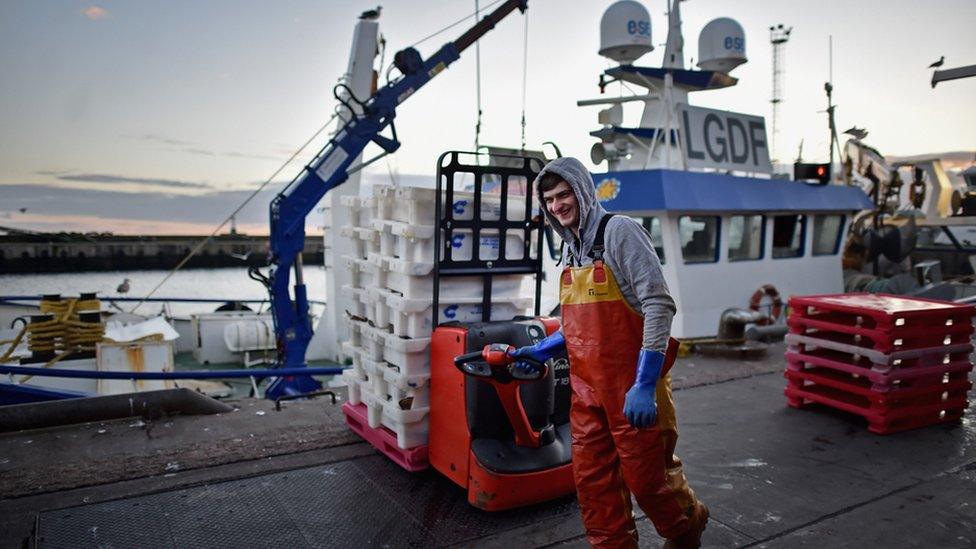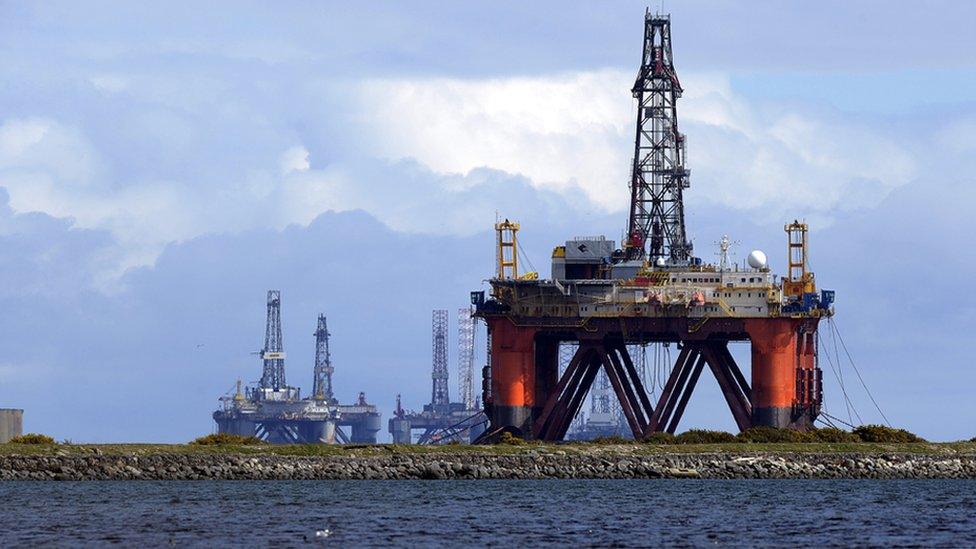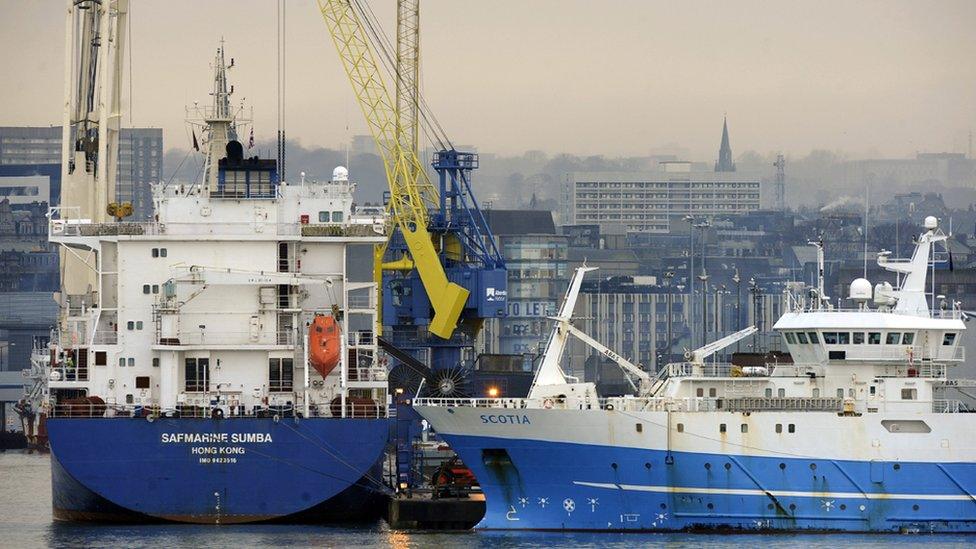Scotland's seas take centre stage
- Published

The Loony Dook takes place in the Firth of Forth on New Year's Day
Scotland's Year of Coasts and Waters 2020 is not just a marketing hook: there are controversies afloat too, including ferry services, shipbuilding, salmon farming and fish quotas.
New figures show how important the maritime economy is to Scotland and the UK, but will oil and gas continue to secure that contribution?
A leading energy consultancy says the North Sea will be a hotspot for investment this year, but mainly in Norway, while pressure is growing to keep oil and gas under the seabed.
The year began with a controversy. How much should the public have to pay to do something really daft, which would otherwise be free?
On the first day of the year, hundreds of hardy souls dive into the chilly waters of the Forth of Forth as part of the annual Loony Dook.
The event's £12 entry fee has been criticised by the original founders, external. People seem willing to pay for doing something deeply unpleasant, despite the fact they could dive in for free at a different point along the coast. Economic theory struggles to put a price on that, and so does common sense.
Maybe there's a lesson for Brexit lost somewhere in the economic chill along the beach at Queensferry. But let's look elsewhere for its symbolism.
The Loony Dook began the Year of Scotland's Coast and Waters. Like the year of food and drink, it's a sort of marketing hook - but the theme of coast and water also carries some difficult messages.
It comes at the start of a year when matters maritime loom large on the horizon:
The COP26 conference in Glasgow in November will raise expectations that Scotland can set an example not just in its ambitious targets, but in cleaning up its seas and coastlines. That should include plastic on the shoreline, but there's pressure also to clean up on aquaculture, at a time when others, in the US and Canada, are cracking down on salmon farming. There will be tussles between the industry and islanders over moves to shift fish farms out from sea lochs and into wilder waters, while greatly increasing their scale.
The fishing industry will watch nervously as Boris Johnson enters the negotiating chamber over the future of the relationship with the European Union. The prime minister and others have raised expectations that control over Britain's fishing waters will be taken back, and a sea of opportunity beckons. But neighbouring EU countries with a fishing industry are preparing to push back, with a threat that if there's no access to their historic fishing grounds, there won't be free access for UK fish exports into the EU.
Last year gave us the saga of the Ferguson shipyard. This year, it will continue and probably intensify. There will be a parliamentary inquiry into what led to nationalisation, while the order for two Cal-Mac ferries went at least twice over its budget and more than three years behind schedule. While those ferries are delayed, islanders wonder if the government-owned ferry operator is going to make up the backlog on ferry-building, at a time when ferries are getting old, less reliable and too small for the current and future levels of demand. Pressure on the government can only increase until those questions are convincingly answered.
The start of 2020 saw the introduction of a lowered permitted standard for sulphur emissions from shipping. For many, that has been an expensive adaptation. The industry will come under continued pressure to improve its performance on climate changing pollution.
That helps explain why the UK Chamber of Shipping marked the turn of the year by trumpeting its importance to the economy. In a year when trade will loom large, aided by rhetoric about "Global Britain", it is ships that will have to do much of the heavy lifting. At present, they carry 95% of Britain's trade in goods.
So we're told we need to appreciate the industry more, recognising that it had turnover of £19bn in 2017, an increase of 41% since 2010 (a bad year for trade, mind). According to analysis by the Centre for Economic and Business Research (CEBR), external, it directly supports 181,000 jobs.
What about Scotland?

The same CEBR recently provided research specific to Scotland's marine sector, commissioned by the Maritime UK trade group.
It reckoned, using figures from 2017, on £9.9bn in turnover, £3.7bn in added value and 41,000 jobs. That's a big share of the UK total: 21% of turnover, 27% of value added and 19% of employment.
With such a long coastline, most of Britain's fishing fleet, ferries to serve its islands, and world-class opportunities for seaborne leisure, it's not hard to see why Scotland might be that way.
But the numbers are skewed heavily by the presence of offshore oil and gas. This, you'll note, is not research just about shipping, but about the wider maritime sector.
Scotland had only 13% of shipping employment in the 2017 analysis, and 10% in ports. It had 27% of shipbuilding employment (the aircraft carriers alliance was busy at Rosyth that year) and 94% of offshore oil and gas jobs.
Those oil and gas jobs account for a generous share of value added, as you should expect from a valuable commodity. The average job equated to £109,000 in 2017.
More was generated, however, by the maritime business services - shipbroking and insurance, for instance - in which London dominates, accounting for £113,000 per person.
Will offshore oil and gas continue to deliver for the Scottish economy?

That's a big question, for the economy, for constitutional politics, and for the environment.
The CEBR forecasts that the Scottish maritime sector will grow at about 2.6% per year up to 2023.
That's twice the rate of the economy as a whole - but it also points out that seaborne global trade is growing at 3.8%. UK government projections are well below that although, over time, they add up to a 39% rise in the volume moving through British ports by 2050.
The study reflects Oil and Gas Authority projections for declining activity in UK waters. It suggests that as less oil comes through pipelines, more will have to reach Britain by tankers.
That's unless the industry adapts to growing demands for action on climate change.
The common justification for keeping the drillers busy in UK waters is that the energy has to come from somewhere: better to make it local than bringing it long distances by tankers.
The selling of the North Sea

Some industry players are becoming increasingly sensitive to public pressure, but not all. While big producers are shifting at least some capital to renewable energy, small producers are moving in on mature fields in the North Sea, with less concern about their public reputations.
Such a move saw BP announce a deal this week to sell its stakes in five central North Sea fields to Premier Oil.
These North Sea sales by UK and US oil majors have, in only three years, totted up to $20bn worth of assets changing hands, according to Wood Mackenzie, the global energy consultancy based in Edinburgh which watches such things closely. Yet about a third of wells are still operated by major producers.
Last year alone, total transactions in North Sea offshore oil and gas came to $15bn - and WoodMac reckons there's a lot more to come this year.
The private equity firms that bought in are now beginning to want to exit, meaning bargain prices. More international buyers are expected, and perhaps some financial players.
North Sea production is forecast to rise for the first time since 2017. And while that is helped by new fields coming onstream in UK waters, including Mariner and Culzean, it's in Norway that the big spending will be found.
Johan Sverdrup, a gigantic field near Stavanger, had its official opening this week. Some two-thirds of the $25bn being invested in the North Sea this year is expected to be in Norway.
Much of that depends on the oil price, of course. And with uncertainty over US-China trade rattling markets, followed by rocket exchanges between Iran and the US, Brent crude has turned volatile again.
That matters a lot for those producing from older reserves in UK waters which are getting ever more marginal and expensive to operate when measured per barrel.
What impact could oil prices have?

Professor Alex Kemp, at Aberdeen University, the guru of North Sea oil economists, recently put out his estimates showing the high price sensitivity of the UK industry.
He offered up three scenarios - a low one with the oil price at $50, and a therm of gas at 35 pence; the middle scenario has oil at $60 per barrel and gas at 45p; and the upside outlook for the industry (not for the environment, you might wish to point out) is oil at $70 and gas at 55p, all in real terms.
Let's see how they perform. According to Professor Kemp, with fellow economist Linda Stephen, low prices could bring in £52bn of development spending up to 2050, and means 8.7 billion barrels or their gas equivalent are extracted.
The middle prices read across to £90bn of spending, to extract 12 billion barrels. And the high price (nearly reached in trading as fears of a US-Iran hot war spiked this week) would, if sustained, spark £113bn of spending for 14.5 billion barrels. Bear in mind that more than 40 billion barrels have been extracted over 45 years.
It's another reminder that the offshore oil and gas industry has a future stretching towards the middle of this century, and more activity still in decommissioning its equipment.
But returning to those climate change talks in Glasgow come November, will decisions made there mean it having to shut down the flow of hydrocarbons long before then?
